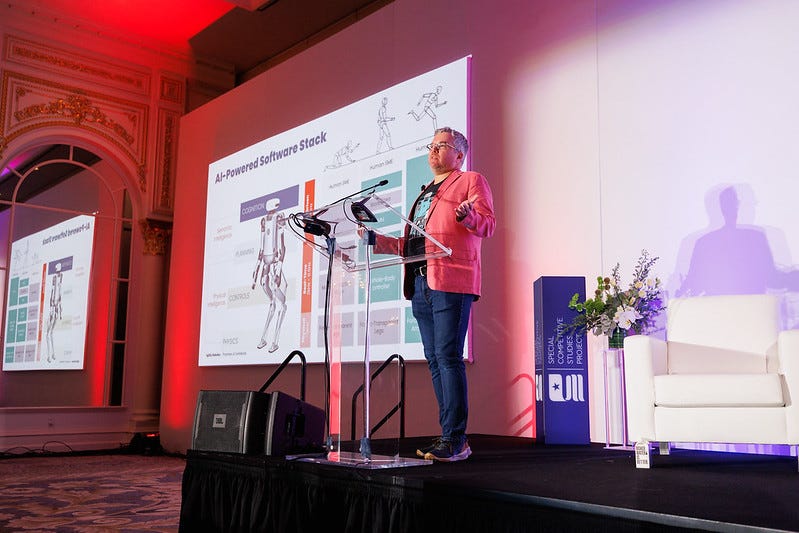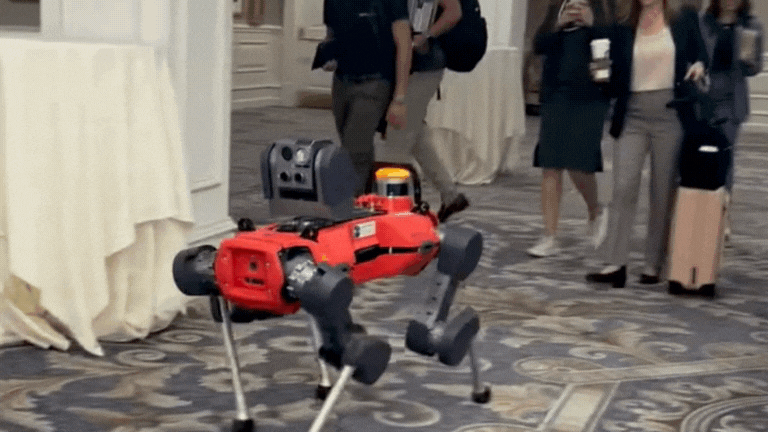Hello, I’m Ylli Bajraktari, CEO of the Special Competitive Studies Project. In this week’s edition of SCSP’s newsletter, SCSP Director for Future Technology Platforms Abby Kukura discusses important takeaways from our AI+ Robotics Summit held last week. We are grateful to everyone who participated.
📌 Upcoming SCSP Events
November 1 - The Ash Carter Exchange in Cambridge, MA. Recently announced speakers include Dr. Joseph Aoun, Dr. Amy Brand, Dr. Noubar Afeyan, Dr. Ava Carter, and more! Join the waitlist here!
November 15 - SCSP x AGI House Hackathon: SCSP is partnering with the Bay Area AI hacker house, AGI House, to host an AI Agents for Gov Hackathon at SCSP’s office in DC. Come create the future of AI agents to solve important real-world challenges. Stay tuned for more details!
Memo to the President: 10 Key Takeaways from the AI+ Robotics Summit
Missed the AI+ Robotics Summit or interested in rewatching sessions? Enjoy the entire event on SCSP’s YouTube Channel.
Introduction
The AI+ Robotics Summit convened leading experts across industry, academia, and government to discuss the convergence of artificial intelligence (AI) and robotics. The sessions highlighted significant technological advancements, underscored the urgency for strategic national action, addressed ethical and societal implications, and emphasized the need for collaborative efforts to maintain global leadership. This newsletter distills the summit’s main takeaways into actionable insights for policymakers and executives.
Tech Competition Factors for AI+ Robotics
Technologists advancing the frontiers of AI and robotics in industry, academia, and government can position the United States for technological advantage by mastering the following technology competition factors.
1. Advances in AI have enabled robotics to move from physics-based problems to natural language solutions. Connecting robotic control systems to large language models (LLMs) has helped the field overcome one of its longest unsolved problems: combining cognitive and physical intelligence into a system that can learn. The next generation of robots will be embodied AI agents that will be powered by multiple forms of computing, including commodity LLMs, simulation computers, and on-device robotic foundation models.
2. There is no Internet-scale database of the physical world, but simulation environments and data from real-world use can help fill this gap. This lack of real-world data has limited robotics deployment to highly constrained environments such as factories and warehouses. Leveraging AI to model robot interactions at machine scale in simulation environments can help bridge this gap. Gathering this simulation data and real-world data from deployed systems into a national database would mitigate a current U.S. competitive disadvantage relative to China.
3. Advanced manufacturing is the ground floor for the AI+ Robotics ecosystem. Factories are a locus of innovation and experimentation in AI-enabled robotics, which heralds a new paradigm of manufacturing. The factory of the future will be flexible, agile, and highly automated, freeing up humans for higher-skilled jobs. Yet, as evidenced by demos at the Summit, these advances will ultimately support a much broader transformation of industries ranging from agriculture to medicine to construction.

National Moves for U.S. Leadership in AI+ Robotics
The U.S. Government can drive comprehensive U.S. leadership in AI and robotics by rallying the ecosystem around a lofty technology ambition, leveraging public-private partnerships, deepening the capital stack, preparing the workforce, and expanding collaboration with allies and partners.
4. An AI+ Robotics "moonshot" could unite players across the U.S. robotics ecosystem to achieve a position of technology advantage. Speakers' moonshot ideas included building a fully lights-out factory and its digital twin, pioneering a new paradigm for flexible manufacturing, investing in the entire backend infrastructure and supply chain for robotics, and leveraging AI-enabled robotics to search for life in outer space.
5. Voluntary public-private partnerships (PPPs) are a U.S. competitive advantage that should be harvested for national leadership. Twenty years ago, DARPA's self-driving challenge helped spur the technological advances that led to breakthroughs in autonomous vehicles. Today, innovation in AI and robotics is being driven by the private sector, but public-private initiatives like the ManufacturingUSA Institutes can help bridge technology gaps, strengthen supply chains, and address workforce challenges.
6. VC investment in U.S. robotics companies is flourishing, but building hardware at scale requires a deeper capital stack. The U.S. Government can de-risk private investment with incentives like investment tax credits for small and medium-sized enterprises, provide a demand signal for priority industries and applications, and leverage the defense industrial base as an initial market that catalyzes broader commercial scale.
7. Like technology eras before it, the rise of AI and robotics will create entire new categories of jobs. Millions of new manufacturing jobs will go unfilled in the next decade if we do not change the trajectory of U.S. manufacturing. We can prepare today's workforce for this shift with credentials and skills programs to help transition into new roles. Training the next generation of talent will require putting AI at the center of learning and cultivating a workforce built for adapting to a rapidly shifting technology landscape.
8. The United States should be learning, mapping, and cooperating on robotics with allies and partners faster than our rivals. The Ukraine war is compressing eras of technology innovation in a similar manner as occurred in World War II. Unmanned ground and air vehicles are rapidly advancing in Ukraine, but it is not clear whether the U.S. military is present to learn those lessons as European nations are. Beyond Ukraine, competitive advantages in robotics across allied and partner nations should be mapped to foster structural cooperation on shared programs.

Securing Global Leadership Amidst Rising Competition
Outcompeting strategic rivals in AI and robotics will require a public-private strategy that harnesses the full strength of the U.S. innovation ecosystem.
9. China is succeeding in robotics by design. These investments and strategic initiatives in AI and robotics pose a competitive challenge to the United States. Last year, China adopted more industrial robots than the rest of the world combined, and when controlling for lower wages, China has a 12 times higher adoption rate than the United States for robots in manufacturing. China's coordinated approach aims to dominate the sector by aggressively adopting new technologies and supporting domestic innovation.
10. Robotics has been an afterthought in U.S. tech strategy. China has outcompeted the United States in scaling and adopting other hardware-based technologies, and the lack of a comprehensive national strategy like China's to proactively master this technological convergence illustrates how robotics is a secondary consideration in our national strategy. The moves sketched above represent the beginning outline of a strategy that would leverage public-private partnerships to combine U.S. advantages in frontier AI and robotics innovation with the policy moves required to win this technological future.
Conclusion
The AI+ Robotics Summit highlighted the transformative potential of integrating AI with robotics across various sectors. Without a strategy, the United States risks falling behind our global competitors. Policymakers and industry leaders must collaborate to designate national technological ambitions, catalyze investment over long time horizons, address ethical considerations, and prepare the workforce for a future where AI and robotics are integral to economic and societal progress.






